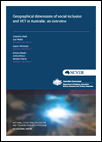Description
This paper provides a conceptual basis for a three-year (2011–13) research program exploring the capacity of individuals and groups to make transitions through learning, training and work across locations. Three research projects will examine how regional or community factors and social capital affect those transitions. The three projects are: the influence of job conditions on geographic labour mobility; migrant women in regional Australia; and neighbourhood factors in the decision to participate in post-school education and training and the labour market. A synopsis of each project is given in this paper.
Summary
About the research
This paper provides an overview and context for the program of research being undertaken by Monash and Deakin Universities, 'Geographical dimensions of social inclusion and VET in Australia'. The overarching purpose of the research is to provide an understanding of the role that education and training can play in reducing the risk of social exclusion and in improving labour force participation.
The projects that constitute the program of research all address aspects of disadvantage faced by groups in different locations. The three projects are:
-
Willingness-to-move: the influence of job conditions on geographic mobility — this project
examines the link between geographic mobility and the type of work available in areas with
apparent excess labour demand. The project is investigating the value that individuals place on various characteristics, such as wages, in their 'willingness to move' decision. -
Migrant women in regional Australia: the role of education and training in improving social
inclusion — this project explores the underutilisation of the skills of migrant women in regional areas and the possible role of education and training in removing barriers, if any, to their participation in the labour force and in other social activities. - Neighbourhood factors in the decision to participate in post-school education and training and the labour market — this project compares the outcomes of education and training in areas of low and high social disadvantage, taking into account differences between the regions in their access to high-quality education and training and other community infrastructure.
This paper considers the socioeconomic and policy context for the research. The various frameworks for conceptualising disadvantage — social capital, the capability approach and social inclusion — are also discussed to enhance understanding of the issues being investigated.
The three research projects span the years 2011 to 2013, with all the reports arising from the research becoming available from NCVER from early 2014.
Tom Karmel
Managing Director, NCVER
Download
| TITLE | FORMAT | SIZE | |
|---|---|---|---|
| Geographical-dimensions-2517 | 673.7 KB | Download | |
| Geographical-dimensions-2517 | .docx | 1.1 MB | Download |
Related items
In this podcast, Sue Webb, a researcher, talks about the initial findings from work looking at the u… Show more
This research report examines the underutilisation of the skills of migrants in regional areas, part… Show more
